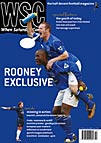 In the past decade, the quest to find Scotland's 'Third Force' has become an increasingly vain one. Gary Panton runs the rule over the brief contenders
In the past decade, the quest to find Scotland's 'Third Force' has become an increasingly vain one. Gary Panton runs the rule over the brief contenders
Just months after completing their meteoric rise from the lower rungs of Scottish football to a third place finish in the top flight, the critics are claiming that Livingston’s bubble has already burst. Ten games into the season, an impressive 4-3 UEFA Cup victory over Sturm Graz could not disguise the fact that the Livi Lions had slumped to the bottom of the SPL.
Recent history suggests Livingston’s struggle to prove there is life after third place isn’t something we should be surprised by. Since 1995, when Motherwell somehow managed to clinch second place in the Premier Division (as it was then known), no team has been able to break the Old Firm’s grip on the top two positions. Such is the national acceptance of Rangers’ and Celtic’s dominance, that the annual battle among the provincial also-rans to be crowned Scotland’s “Third Force” has long since abandoned any hint of tongue-in-cheek. For ten of the 12 SPL clubs, bronze is very much the new gold.
Yet, perhaps surprisingly, no club has managed to take the title of Third Force and make it their own. In the seven seasons that have passed since Motherwell’s runner-up year, six different clubs have finished third. Only Hearts have managed it twice, and even they were unable to muster consecutive terms of Third Force “glory”. Aberdeen, Dundee United, St Johnstone and Hibs are the other clubs to have tried and failed to emulate a top three finish.
Of those, none has suffered more since their brief flirtation with success than St Johnstone. After a best-ever season in 1998-99 that saw them embellish their top three position with a League Cup final, Scottish Cup semi-final and qualification for Europe to boot, the Perth Saints embarked on a dismal four-year downward spiral. Last season, the McDiarmid Park club finished a whopping 19 points adrift of safety, exchanging their top-flight status for the crumbling terrace surroundings of the First Division.
You would be forgiven for expecting Aberdeen, Dundee Utd, or either of the Edinburgh clubs to put up a considerably stronger fight for Third Force status. Unlike St Johnstone, who play in a small town not exactly noted for its contribution to global football fever, they all draw their support from substantial cities.
Aberdeen, in particular, have consistently under-achieved since their last third place finish way back in 1995-96. With a population of 415,000 in their home city and no other top flight outfit playing within a 70-mile radius, the Dons should have their pick of the north’s “floating” supporters. Add to that their considerable distance from the infamous central belt region (Scotland’s answer to the Bermuda Triangle when it comes to residents disappearing from their local club’s aid in favour of Old Firm allegiances), and it’s pretty hard to fathom why Pittodrie hasn’t become the recognised home of the Third Force.
Perhaps Dundee Utd have more of an excuse for their woeful showing in recent years. They share their city’s 148,000 population with neighbours Dundee, and have had so many problems off the pitch of late that it seems the situation on it has become of almost secondary importance. This season, yet another year of loitering nerve-rackingly close to the drop zone looks far more likely than any kind of push for success.
Hearts’ recent off-field problems have been similarly well-documented. Their chief executive Chris Robinson, a long-standing hate figure among much of the Tynecastle faithful, somehow managed to guide the club into deep trouble, despite receiving a mammoth £8 million investment from media big-hitters SMG. Craig Levein has done a near-miraculous job in gradually rebuilding the Jambos as a force to be reckoned with on a budget of next to nothing, but at the time of writing they are still trailing Dunfermline, who look a reasonable bet to add yet another name to the list of alternative champions come May.
Across the capital, Hibs appear to be still recovering from the shock of being drawn into a relegation battle just 12 months after romping away with the “Best of the Rest” title. After their third place, the outstanding Russell Latapy moved on to Rangers, following the familiar trail of players such as David Hannah (Dundee Utd to Celtic), Paul Ritchie (Hearts to Rangers), Billy Dodds (Dundee Utd to Rangers) and Kenny Miller (Hibs to Rangers) to name only a few.
Hibs weren’t the first club to achieve success only to struggle to keep their side together. Neither, for as long as the Old Firm snap up the best of the opposition talent for perennial bench-warming roles, will they be the last. Indeed, Livingston’s David Fernandez moved to Celtic for £1 million in the summer. So far he has made one league start.
From WSC 190 December 2002. What was happening this month